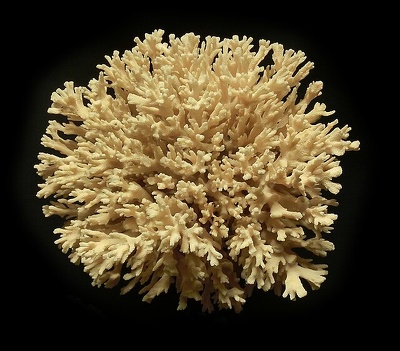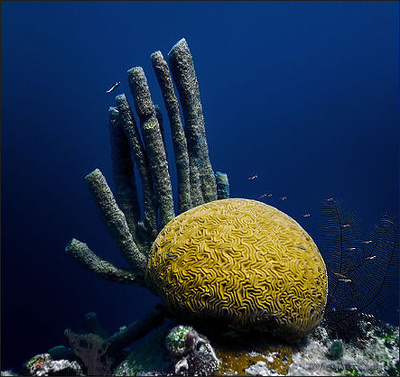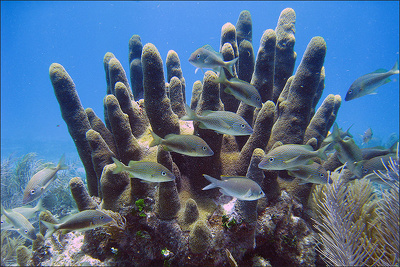Home | Category: Coral Reefs / Coral Reef Life
TYPES OF CORAL
_with_extended_polyps_at_night.jpg)
Hard coral with extended polyps at night True corals are divided into four groups: 1) stony, or hard, coral (Order “ Madreporaria” and “ Sceleractinia” ); 2) horny corals ( “ Gorgonacea” ); 3) branching corals (“ Antipatharia” ); and 4) one species of blue coral (“ Coenothecalia” ).
There are several kinds of corals, of which hard (stony) species are the most numerous. Solitary corals are found in most of the world's oceans but they only form large reefs in tropical waters above 68̊F. The distribution of corals is relatively uneven. There are 67 coral species in the Caribbean Sea, compared around 450 in the Pacific and Indian Oceans around Malaysia, Indonesia, the Philippines, Papua New Guinea and Australia.
There are about 4,000 coral species. Each coral has its own system of budding and this produces the shape of the colonies unique to each kind of coral. Beautiful organ-pipe coral, which expands like a flower, is a close relative of soft corals (See Below). The organ pipes are a mass of vertical tubes, joined at intervals throughout their length by thin horizontal plates. The purplish skeleton contains a pale lilac-colored polyp.
Many coral depend primarily on suspension feeding of small marine invertebrates. They also feed on marine worms, aquatic crustaceans and zooplankton and have a symbiotic relationship with algae which supply the coral with nutrients and energy for calcification and growth. Many corals capture food with expanded tentacles suggesting a tactile response to the environment. Common coral predators include gastropods, polychaetes, echinoids, asteroids, pycnogonids, and fishes, such as parrotfish. [Source: Animal Diversity Web]
Related Articles: CORAL REEFS: TYPES, PARTS, COMPOSITION AND BENEFITS ioa.factsanddetails.com ; CORAL: POLYPS, ALGAE, EGGS, MASS SPAWNS ioa.factsanddetails.com ; CORAL REEF LIFE ioa.factsanddetails.com ; REEF FISH ioa.factsanddetails.com ; ISLANDS: TYPES, HOW THEY FORM, FEATURES AND NATIONS ioa.factsanddetails.com ; GLOBAL WARMING AND THE SEA ioa.factsanddetails.com ; OCEAN ACIDIFICATION ioa.factsanddetails.com ; ENDANGERED CORAL REEFS AND THEIR RECOVERY AND REBIRTH ioa.factsanddetails.com ; GLOBAL WARMING AND CORAL REEFS ioa.factsanddetails.com ; CORAL BLEACHING: CAUSES, CONSEQUENCES AND RECOVERY ioa.factsanddetails.com ; DIRECT HUMAN IMPACTS ON CORAL REEFS: POLLUTION, OVERFISHING AND CYANIDE AND DYNAMITE FISHING ioa.factsanddetails.com ; HELPING CORAL RECOVER AND REVIVE ioa.factsanddetails.com
Websites and Resources: Animal Diversity Web (ADW) animaldiversity.org; National Oceanic and Atmospheric Administration (NOAA) noaa.gov; “Introduction to Physical Oceanography” by Robert Stewart , Texas A&M University, 2008 uv.es/hegigui/Kasper ; Fishbase fishbase.se ; Encyclopedia of Life eol.org ; Smithsonian Oceans Portal ocean.si.edu/ocean-life-ecosystems ; Woods Hole Oceanographic Institute whoi.edu ; Cousteau Society cousteau.org ; Monterey Bay Aquarium montereybayaquarium.org ; MarineBio marinebio.org/oceans/creatures ; Websites and Resources on Coral Reefs: Coral Reef Information System (NOAA) coris.noaa.gov ; International Coral Reef Initiative icriforum.org ; Wikipedia article Wikipedia ; Coral Reef Alliance coral.org ; Global Coral reef Alliance globalcoral.org ;Global Coral Reef Monitoring Network gcrmn.net
Hard Corals
Hard corals are the primary reef-building corals. They are essentially tiny sea anemones with a communal skeleton. They sting to the touch like larger anemones. Many kinds of fish, shrimp and other sea creatures have evolved to live with few side effects among the coral with the tentacles offering protection and escape from predators. Many resemble the coral they live among, a features called crypis. [Source: NOAA]
Stony coral, the builders of reefs, form colonies in mound like shapes that sometimes don’t get as much access to sunlight as other kinds of coral but are more likely to weather storms. There are about a thousand species of hard , stony coral, making them the most diverse and widely distributed coral. Living either solitary or alone, hard corals are found in all tropical oceans and grow best at depths of less than 30 meters though there are some species that grow to depth of 7,000 meters. Stony coral can be shaped like mushrooms, moose antlers, cabbages, tabletops, fluted pillars and wrinkled brains.
The 1,200 species of horny coral thrive in shallow waters. They include varieties include elkhorn, and staghorn corals. Many species of branching corals have ribbon-like branches that occasionally grow to lengths of three meters. This adaption help the coral thrive after getting a small toe hold on the reef and deprives competitors of sunlight. But its shape also makes it vulnerable in storms. There are about a hundred species of branching coral.
Soft Corals
Soft corals, which resemble underwater plants or trees, lack a hard outer skeleton. For the most part they do not form reefs, though they are present in reef ecosystems. Soft corals are relatively under-researched. Soft corals are not true corals. What sets soft coral polyps apart from other normal corals are their tentacles, which are more complex and fringed than tentacles on true corals. In addition, soft coral polyps have eight tentacles as opposed to six or multiples of six as is the case with true corals.
"Soft corals" are placed in the class Octocorallia, which also includes blue coral, sea pens, and gorgonians. While soft corals don’t fit together neatly in a strict taxonomic sense, they are quite different from "true" corals (Scleractinia). The term “soft coral” generally applies to organisms in the two orders Pennatulacea and Alcyonaceae, which have their polyps embedded within a fleshy mass of coenenchymal tissue. The term “gorgonian coral” is commonly used for multiple species in the Alcyonaceae order that produce a mineralized skeletal axis (or axial-like layer) composed of calcite and the proteinaceous material gorgonin. [Source: Wikipedia]
Fiji is particularly well known for soft corals. Soft Dendronephtya corals — associated most with Fijian reefs — do not have symbiotic algae — and therefore are not vulnerable to bleaching. Unlike reef building hard corals that need sunlight to thrive in shallow waters, soft corals like Dendronephtya corals can live a range of depths. They are often found on seawalls and overhangs and come in a variety of vivid colors.
Some of the toxins found in soft corals are anti-inflammatory agents that have the potential of treating cancer, AIDS and a host of other ailments. Many soft corals are easily collected in the wild for the reef aquarium trade, as small cuttings are less prone to infection or damage during shipping than stony corals. Soft corals grow quickly in captivity and are easily divided into new individuals, and so those grown by aquaculture are often hardier and less expensive than imported corals from the wild.
Soft Coral Characteristics
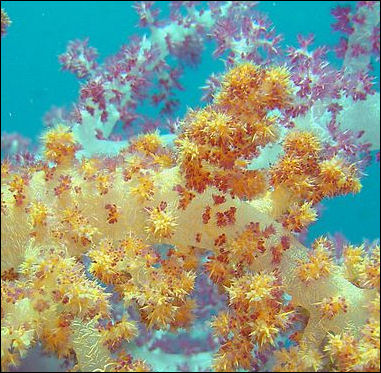
soft coral "Soft corals" are sessile colonial cnidarians that are found throughout the oceans of the world, especially in the deep sea, polar waters, tropics and subtropics. They contain minute, spiny skeletal elements called sclerites, useful in species identification. Sclerites give these corals some degree of support and give their flesh a spiky, grainy texture that deters predators. In the past, soft corals were thought to be unable to lay new foundations for future corals, but recent findings suggest that colonies of the leather-coral genus Sinularia are able to cement sclerites and consolidate them at their base into alcyonarian spiculite, thus making them reef builders. [Source: Wikipedia]
Unlike stony corals, most soft corals thrive in nutrient-rich waters with less intense light. Almost all use symbiotic photosynthetic zooxanthella as a major energy source. However, most readily eat any free-floating food, such as zooplankton, out of the water column. They are integral members of the reef ecosystem and provide habitat for fish, snails, algae, and a diversity of other marine species.
Soft corals inflate their entire bodies. At night, soft coral expand their bodies to four or five times their daytime size, extending their polyps to snag more plankton and waving in the current as they do so. Soft corals extend their polyps to feed on zooplankton. Fishes such as wrasse hang out among the branches and feed on the same source of food. Soft coral trunks and limbs stiffen with a scaffold of limestone splinters called sclerites, When threaded by storms or preying fish, the coral deflates into spiny balls. Many creatures have adapted to the soft coral environment by taking on an appearance similar to that of their hosts. [Source: National Geographic]
Brain Corals
Brain corals, a slow-growing species of coral, often act as foundations for reefs. They can grow six feet tall and live for up to 900 years! Found in the Caribbean, Atlantic, and Pacific Oceans, brain corals display what is known as Meandroid tissue integration. This means that the polyps, which are the basic living unit of corals, are highly associated to one another. Their tissues are more closely connected than those of other corals and are not separated by skeletal structures. Many researchers think that the more integrated a coral's polyp tissue is, the more advanced the coral species. [Source: NOAA]
Tissue integration is advantageous because the coral polyps are able to transfer molecules such as nutrients, hormones, and oxygen — making it easier for the brain coral colony to communicate. In some cases, however, this can lead to vulnerability, because if even one polyp gets sick, the pathogen can quickly spread to the rest of the colony. Some species of brain corals suffer mass mortalities due to diseases such as black band disease, white plague, and thermal bleaching.
Grooved brain coral (Diploria labyrinthiformis) is found in the Caribbean, Bahamas, southern Florida, and Bermuda and tends to grow on less solid and loose substrates of the ocean floor. Diploria are found in high abundance in some reefs when compared to other corals, at least partly because the genus Diploria has lower juvenile mortality rates than other coral groups.[Source: Brooke Johnson, Animal Diversity Web (ADW) /=]
Grooved brain coral is in the order Scleractinia, stony corals. The optimum temperature for adult Scleractinia coral is between 25 and 29 degrees Celsius (77 to 84 degrees F); the absolute minimal temperature is 18 degrees Celsius (64 degrees F),. Because it has a single-celled symbiotic algae within its cells, grooved brain coral needs to be at depths where light can penetrate the water — 50 meters (164 feet) deep or less. Brain coral can live in high areas of sediments. /=\
According to Animal Diversity Web: Grooved brain coral has very distinct valleys that contain polyps, and deeper grooves beneath the ridges. The valleys are 5-10 millimeters wide, up to six millimeters deep and u-shaped in a cross section. The ridges are wider than valleys, up to 15 millimeters, and have a concave profile with edges 2-4 millimeters higher than the rest of the ridge. Right angles of the plates, or septa, make it look like there are double combs in the valleys. Crests, or costae, of the septa form across the valley walls. /=\
Brain corals are cold blooded (ectothermic, use heat from the environment and adapt their behavior to regulate body temperature), heterothermic (having a body temperature that fluctuates with the surrounding environment), have radial symmetry and reach a length of two meters (6.56 feet). It coral tends to grow to longer lengths when inhabiting shallow waters. Grooved brain coral can be a variety of colors including tans, yellows, and grays. Polyp retract it's tentacles in the daytime, and extend them to feed at night. /=\
Brain Coral Development and Reproduction
The life cycle of brain coral is characterized by metamorphosis — a process of development in which individuals change in shape or structure as they grow. It has a broadcaster mode of development. This means it is fertilized internally and then releases eggs into the ocean. The eggs hatch into swimming planktonic planulae larvae, which settle on an appropriate substrate, where asexual reproduction begins. Secondary polyps are formed, which develop to adult polyps. The polyps can grow at a rate of 3.5 millimeters per year. [Source: Brooke Johnson, Animal Diversity Web (ADW) /=]
Brain coral engage in seasonal breeding, employ both sexual and asexual reproduction, engage in internal reproduction in which sperm from the male parent fertilizes an egg from the female parent and are oviparous, meaning that young are hatched from eggs. The breeding season for grooved brian coral is from late May to late June. Ther is no known parental care. Eggs are released after they are fertilized./=\
Grooved brain coral is hermaphroditic, with an annual gametogenic cycle with a 10-11 month period for gonad (sex organ) development. Spawning likely begins as a result of environmental cues such as high air temperature, low number of solar hours per month, low wind velocity, and initiation of the rainy season. Grooved brain coral has an average of four mature eggs and six spermatic cysts per fertile mesentery (a membrane inside the body cavity of an animal). Eggs and spermatic cysts are located towards the aboral (opposite the mouth) part of the mesentery. /=\
Elkhorn Coral
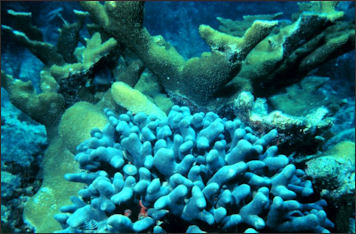
elkhorn coral Elkhorn coral (Scientific name: Acropora palmata) is one of the most important corals in the Caribbean. It, along with staghorn coral and star corals (boulder, lobed, and mountainous), built Caribbean coral reefs over the last 5,000 years. Elkhorn coral can form dense groups called “thickets” in very shallow water. These provide important habitat for other reef animals, especially fish.[Source: NOAA]
Elkhorn coral used to be a dominant coral on Caribbean reefs and was so abundant that an entire reef zone is named for it. Beginning in the 1980s, the elkhorn coral population declined 97 percent from white band disease. This disease kills the coral’s tissues. Currently, there are locations such as the U.S. Virgin Islands where populations of elkhorn coral appear stable at low abundance, and some such as the Florida Keys where population numbers are decreasing. Successful reproduction is very rare, so it is hard for elkhorn coral populations to increase.
Elkhorn coral can live up to hundreds of years and can be to three meters (12 feet) in diameter and two meters (6 feet) in height. A study by researchers at Penn State University in 2016 found that some genotypes of elkhorn coral in Florida and the Caribbean are more than 5,000 years old. [Source: Zoë Miller, Azmi Haroun, Business Insider, December 25, 2022]
Elkhorn coral is found typically in clear, shallow water 30 centimeters to five meters (1 to 15 feet) deep on coral reefs throughout the Bahamas, Florida, and the Caribbean. The northern extent of the range in the Atlantic Ocean is Broward County, Florida, where it is relatively rare (only a few known colonies). Elkhorn coral lives in high-energy zones, with a lot of wave action. Too much wave action (major storms) can cause this branching coral to break. However, fragmentation via branch breakage is one method of reproduction for elkhorn coral.[Source: NOAA]
Elkhorn Coral Characteristics and Reproduction
Elkhorn coral colonies are golden tan or pale brown with white tips, and they get their color from the algae that live within their tissue. Elkhorn corals have frond-like branches, which appear flattened to near round, and typically stem out from a central trunk and angle upward. Branches are up to 15 inches wide and range in thickness from 1 to 2 inches. Individual colonies can grow to at least 6 feet in height and 12 feet in diameter. Elkhorn coral colonies can grow in dense stands and form an interlocking framework known as thickets. Each elkhorn coral colony is made up of many individual polyps that grow together. Each polyp is an exact copy of all the polyps in the same colony.[Source: NOAA]
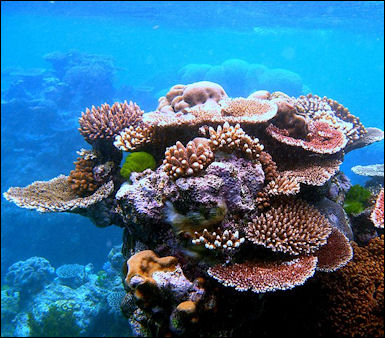 Elkhorn coral get food from photosynthetic algae that live inside the coral's cells. They also feed by capturing plankton with their polyps’ tentacles. Coral bleaching is the loss of the algae that live in coral tissue. This loss can lead to coral death through starvation or increased vulnerability to diseases. Due to their tree-like growth form, elkhorn corals provide complex habitat for fish and other coral reef organisms. When elkhorn corals are abundant, they provide shoreline protection from large waves and storms.
Elkhorn coral get food from photosynthetic algae that live inside the coral's cells. They also feed by capturing plankton with their polyps’ tentacles. Coral bleaching is the loss of the algae that live in coral tissue. This loss can lead to coral death through starvation or increased vulnerability to diseases. Due to their tree-like growth form, elkhorn corals provide complex habitat for fish and other coral reef organisms. When elkhorn corals are abundant, they provide shoreline protection from large waves and storms.
Elkhorn coral reaches reproductive maturity at about 2,000 square centimeters (two square feet). It is a simultaneous hermaphrodite, meaning each colony produces both eggs and sperm, but usually does not self-fertilize. Elkhorn coral sexually reproduces once per year after the full moon in late summer by “broadcast spawning” eggs and sperm into the water column. Fertilized eggs develop into larvae that settle on hard surfaces and form new colonies. Elkhorn coral can also form new colonies when broken pieces, called fragments, re-attach to hard surfaces. Elkhorn coral is one of the fastest growing corals — when healthy, it can grow up to 5 inches in branch length per year.[Source: NOAA]
Staghorn Coral
Staghorn coral ( Scientific name: Acropora cervicornis) is one of the most important corals in the Caribbean. It, along with elkhorn coral and star corals (boulder, lobed, and mountainous) built Caribbean coral reefs over the last 5,000 years. Staghorn coral can form dense groups called “thickets” in very shallow water. These provide important habitat for other reef animals, especially fish.[Source: NOAA]
Staghorn coral used to be a dominant coral on Caribbean reefs and was so abundant that an entire reef zone is named for it. Beginning in the 1980s, the staghorn coral population declined 97 percent from white band disease. This disease kills the coral’s tissues. Populations appear to consist mostly of isolated colonies or small groups of colonies compared to the vast thickets once prominent throughout its range, with thickets still a prominent feature at only a handful of known locations. Successful reproduction is very rare, so it is hard for staghorn coral populations to increase.
Staghorn coral can live up to hundreds of years and reach up to 2½ meters (8 feet) in diameter, 1.2 meters (4 feet) in height. Staghorn coral is found typically in clear, shallow water five to 14 meters (15 to 60 feet) on coral reefs throughout the Bahamas, Florida, and the Caribbean. The northern extent of the range in the Atlantic Ocean is Palm Beach County, Florida, where it is relatively rare. Staghorn coral lives in many coral reef habitats including spur and groove, bank reef, patch reef, and transitional reef habitats, as well as on limestone ridges, terraces, and hardbottom habitats.[Source: NOAA]
Staghorn Coral Characteristics and Reproduction
Staghorn coral colonies are golden tan or pale brown with white tips and they get their color from the algae that live within their tissue. Staghorn corals have antler-like branches and typically stem out from a central trunk and angle upward. Branches are typically 2.5 to 7.5 centimeters (1 to 3 inches) thick. Individual colonies can grow to at least 4 feet in height and 6 feet in diameter. Staghorn coral colonies can grow in dense stands and form an interlocking framework known as thickets. Each staghorn coral colony is made up of many individual polyps that grow together. Each polyp is an exact copy of all the polyps in the same colony.[Source: NOAA]
Staghorn coral get food from photosynthetic algae that live inside the coral's cells. They also feed by capturing plankton with their polyps’ tentacles. Coral bleaching is the loss of the algae that live in coral tissue. This loss can lead to coral death through starvation or increased vulnerability to diseases. Due to their bush-like growth form, staghorn corals provide complex habitat for fish and other coral reef organisms. When staghorn corals are abundant, they provide shoreline protections from large waves and storms.
Staghorn coral reaches reproductive maturity at about 7 inches tall. Staghorn coral is a simultaneous hermaphrodite, meaning each colony produces both eggs and sperm, but usually does not self-fertilize. Staghorn coral sexually reproduces once per year after the full moon in late summer by “broadcast spawning” eggs and sperm into the water column. Fertilized eggs develop into larvae that settle on hard surfaces and form new colonies. Staghorn coral can also form new colonies when broken pieces, called fragments, re-attach to hard surfaces. Staghorn coral is one of the fastest growing corals — when healthy, it can grow up to 8 inches in branch length per year.
Star Coral and Pillar Coral
Lobed star coral (scientific name: Orbicella annularis) is a species of coral that lives in the western Atlantic Ocean. It is the most thoroughly studied and most abundant species of reef-building coral in the Caribbean to date. It grows into varying colony shapes (heads, columns, plates) in response to differing light conditions. It can live up to hundreds of years and has brown lobes and bumps.[Source: NOAA]
Boulder star (Scientific name: Orbicella franksi) is a coral species native to shallow waters in the Caribbean Sea, the Gulf of Mexico, the Bahamas, Bermuda and Florida. Colonies of boulder star coral usually form massive clumps with uneven surfaces and sometimes they form plates. They are usually orange-brown, greenish-brown or grayish-brown, but the extremities of the lumps are often pale or white. Boulder star coral lives up to hundreds of years and is listed as threatened under the Endangered Species Act.
Mountainous star coral (scientific name Orbicella faveolata) can be found in the Caribbean Sea and the Gulf of Mexico. Its color is usually pale brown but may be deep brown with fluorescent green highlights. Mountainous star coral is listed as threatened under the Endangered Species Act.
Pillar coral (Dendrogyra cylindrus) is a hard coral found in the western Atlantic Ocean and the Caribbean Sea. It often resembles fingers or a cluster of cigars, growing up from the sea floor. Pillar coral is listed as threatened under the Endangered Species Act. It can live up to hundreds of years but is threatened by climate change (including ocean warming and ocean acidification), diseases, habitat degradation and land-based sources of pollution. Threatened throughout its range it is protected by the Endangered Species Act (ESA, U.S. Fish and Wildlife) and Convention on International Trade in Endangered Species (CITES) Appendix II, which lists species not necessarily threatened with extinction now but may become so unless trade is closely controlled:
Corals Found in Pacific Ocean
The main types of Indo-Pacific stony corals are Pocillopora, Acropora Pavona, and Porites. Porites make up a genus of small polyp stony (SPS) corals. They are characterised by a finger-like morphology, widely spaced calices, well-developed wall reticulums and bilateral symmetry. Porites, particularly Porites lutea, often form microatolls. Corals of this genus often serve as hosts for Christmas tree worms. Porites are found in reefs throughout the world. It is a dominant taxon on the Pandora platform of the Great Barrier Reef. The oldest of six colonies in this reef was approximately 700 years old, and was estimated to be growing at 10.3 mm a year [Source: Wikipedia] .
Pavona is a genus of colonial stony corals in the family Agariciidae. Found in shallow waters in the Indo-Pacific region, they have a range of different forms including ones that are massive, meandering, columnar, leaf-like, and plate-like. A single species may vary in form according to the current, wave action, lighting conditions, and depth of its location. Members of the genus are distinguished from other corals by having no walls to the corallites, but having clearly delineated septocostae that connect each corallite to its neighbours, giving a flower-like pattern on the surface of the coral. The corallites themselves are shallow depressions with central columella and may be separated by ridges. The polyps, with the exception of Pavona explanulata, are only extended at night. The foliose and plate-like forms tend to be two-sided. If they do not get enough nutrients or “food” from photosynthesis they switch to the autotrophic mode, and obtain some of their nutrition from their symbiotic algae. They can also absorb nutrients from uptaking dissolved organics from the water and even using carbon dioxide to turn it in organic carbon sources they can feed on.
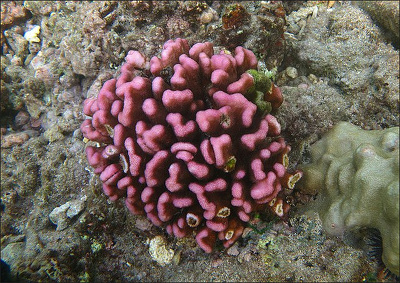
cauliflower coral in Reunion
Acropora is a genus of small polyp stony coral. Some of its species are known as table coral, elkhorn coral, and staghorn coral. Over 149 species have been described. Acropora species are some of the major coral reef builders. Acropora retusa is a species of coral found in U.S. waters in Guam, American Samoa, and the Pacific Remote Island Areas. Colonies of Acropora retusa are made up of flat plates with short, thick finger-like branches. Branches look rough and spiky because radial corallites are variable in length. Colonies are typically brown or green in color. Acropora retusa is listed as threatened under the Endangered Species Act. Anacropora spinosa is a species of coral likely to be found in the Coral Triangle area (the Philippines to Timor Leste and east to the Solomon Islands). It is also confirmed to occur in southern Japan. Colonies of Anacropora spinosa have compact branches that are pale brown in color, occasionally with white tips.
Cauliflower Corals
Pocillopora is a genus of stony corals in the family Pocilloporidae occurring in the Pacific and Indian Oceans. They are commonly called cauliflower corals and brush corals. Cauliflower corals are widespread and can be identified by the presence of wart-like growths on their surface. The colonies can be dome shaped or branching and are very variable in colour and shape depending on the species and the environmental conditions. Species situated on shallow reefs pounded by the sea tend to be stunted whilst those in deep calm water are often thin and open. Each individual polyp has tentacles but these are normally extended only at night.
Pocillopora meandrina (sometimes called cauliflower coral) is found in coral communities at depths of 1 to 27 meters, commonly on shallow reefs exposed to strong wave action. It is found on most coral reefs of the Indo-Pacific and eastern Pacific, with a range extending from the Seychelles Islands in the Indian Ocean to the west coast of Central America in the eastern Pacific. The species is found in all U.S. Pacific Islands jurisdictions. Colonies of Pocillopora meandrina are small upright bushes, with branches radiating from the initial point of growth. Branches are flattened and covered by bumps called verrucae. Colonies are usually cream colored, but can also be green or pink.[Source: NOAA]
Rare Pacific Coral

soft coral Cantharellus noumeae is a naturally rare species of coral endemic to the New Caledonia area of the South Pacific with a restricted range size. It is a cup-shaped fungiid or mushroom coral that stays attached to the substrate for its entire life. It may be solitary or grow in small colonies. It reaches lengths of up to 7.5 centimeters (3 inches) and has a lifespan of around 10 years. [Source: NOAA]
Considered rare as few records of the species exist despite numerous coral reef surveys in New Caledonia over the last decade. The species has small spatial distribution and is also thought to have low genetic diversity due to its small population size. C. noumeae faces the destruction and degradation of its habitat through climate change and mining activity.
Cantharellus noumeae is a mushroom coral which gets its genus name from the scientific name of chanterelle mushrooms, which this species resembles. The coral is mottled brown in color, and has relatively small polyps (25-65 millimeters in diameter) that are cup-shaped with wavy margins. The species gets most of its energy from photosynthetic algae, zooxanthellae, that live inside the coral’s cells. It is thought that like other fungiid corals, the species is able to shed sediment that may fall on it in its highly turbid environment.
Cantharellus noumeae occurs in enclosed bays, settling on hard substrates in silty and muddy habitats at approximately 5 to 30 meters depth. The reproductive methods of the species remain unknown, though they are likely the same as those used by other fungiid corals. This could include both asexual (budding or fragmentation) and sexual (broadcast spawning) methods of reproduction.
The economy of New Caledonia is driven by nickel mining, and the country is currently the fifth largest producer of nickel in the world. The nickel mining industry of New Caledonia threatens C. noumeae through increased soil erosion and introduction of sediments and metals to the marine environment. Exposure to increased sedimentation and metal pollutants including iron, nickel, copper and cobalt have been shown to reduce calcification rates (the rate at which corals can build their skeleton) and cause bleaching in corals, which may lead to mortality.
Black Coral, Fire Coral and Jewelry
Living black coral can be white, gray, green, orange and even bright yellow. Their name comes from the color of their exoskeletons. By some reckonings black corals are not "true" corals. They are anatomically different and do not have a skeleton of calcium carbonate but rather one made of a semiprecious, ebonylike protein that is similar to insect cuticle. The protein is yellow-brown in color but looks black when layers of it are bonded together. Black corals form shrublike colonies with well-defined branches. They release both eggs and larvae at dusk and dawn around the time of ceratin full moons.
Rose, black and blue coral are prized by jewelry makers. Fire coral cause a burning sensation on skin. Among the more colorfully-named corals are sea whip (which can can reach lengths of five meters); “bubble” coral (comprised of skeletal ridges filled with water that resemble bubbles), "daisy" coral (crowned by anemone-like tentacles), "castle" coral (stony corals that grow in pinnacles and are covered with linear patterns), "leather" coral (a soft coral with a spongelike consistency), and "wire" coral (which often spirals out of caves to pull in food from passing currents).
Fire coral (Scientific name: Millepora alcicornis) are native to the tropical and subtropical Atlantic Ocean and the Caribbean Sea. Found in fixed colonies connected to one another by tubular extensions of the body cavity, they create a calcareous skeleton and live attached to rocks and dead coral on reefs in colonies spread over an area of to several meters. The coral paralyse prey with nematocysts (stinging cells) , then draw the prey into mouth opening. Reproduction is sexual: a fertilized egg develops into a small mobile larva covered with moving hairs (cilia); larvae generally planktonic. [Source: Noah Hall, Animal Diversity Web (ADW) /=]
According to Animal Diversity Web: The presence of fire coral may be a blessing to the Endangered coral reefs of the Caribbean. Because the fire coral cause a painful sting in humans, many divers are very cautious about touching the reefs or inadvertently crashing into them. Such contact is very harmful to the true corals that make up the reefs, as many reefs are dying from excessive human impact. /=\
Image Sources: Wikimedia Commons; YouTube, Animal Diversity Web, NOAA
Text Sources: Animal Diversity Web (ADW) animaldiversity.org; National Oceanic and Atmospheric Administration (NOAA) noaa.gov; Wikipedia, National Geographic, Live Science, BBC, Smithsonian, New York Times, Washington Post, Los Angeles Times, The New Yorker, Reuters, Associated Press, Lonely Planet Guides and various books and other publications.
Last Updated March 2023

